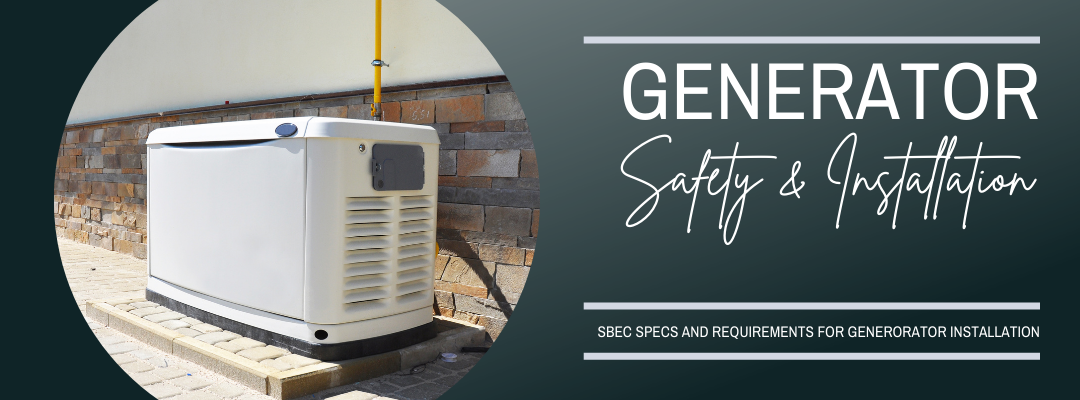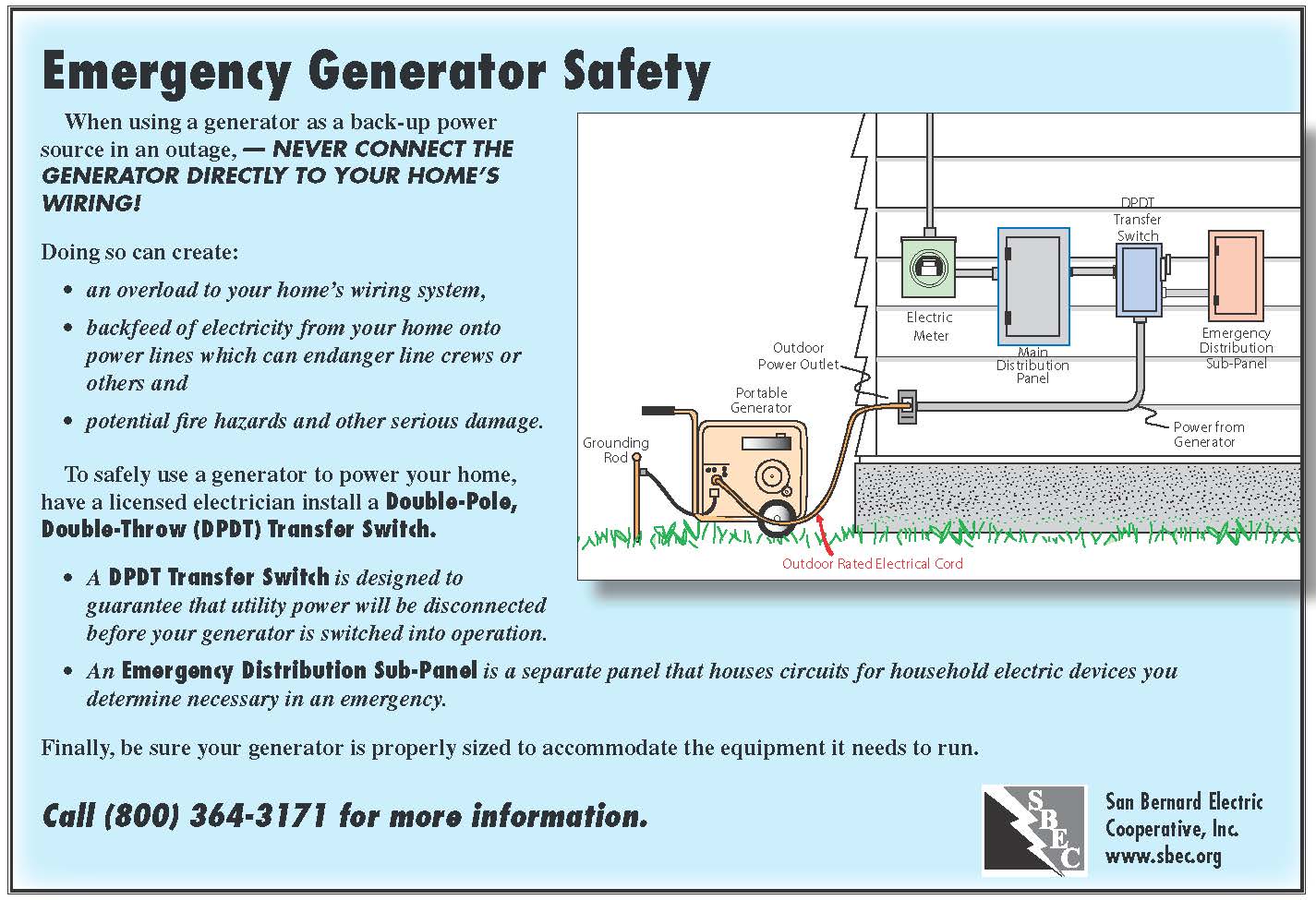
Generators are a handy addition to any household, and they can certainly make life easier when power disruptions occur. Below is information regarding selecting a generator, how to use it safely, and how to connect a generator to your home.
Generator Switch Installation Information
Any member with backup generator intended to power the entire home must have a member-owned automatic transfer switch (ATS) that is approved by San Bernard EC and meet National Electric Code (NEC) requirements.
Automatic Transfer Switch (ATS) Installation Requirements:
- If the ATS is to be utilized as an emergency disconnect, it must be rated as SERVICE EQUIPMENT and must be able to disconnect all power sources. (Utility and Generator)
- Note: If the circuit breaker is switched off and the generator starts and supplies power, the ATS does not meet San Bernard Electric Cooperative requirements, and an additional disconnect will be required.
- All equipment shall be installed to meet the latest NEC requirements. If you are adding to existing equipment, all equipment must be brought up to code.
- All service conductors shall be sized equivalent to the existing service conductors or to the required size for new service installation requirements as per SBEC specifications.
Equipment Location:
- If a transfer switch is serving in place of the main panel, It may be installed on SBEC's pole. Transfer switches are not permitted in addition to an existing panel.
- The generator equipment shall not be installed closer than 10’ from any overhead utility equipment.
- The generator equipment shall not be placed closer than 10’ from the side or rear of a pad mounted transformer and 10’ from the front. The equipment shall not be placed on top of the primary or secondary conductors. Call 811 to have the area marked prior to any installation.
- Adequate room must be left around SBEC equipment for maintenance access.

Generator Selection
If you live somewhere where storms and severe weather cause frequent power outages, you may be considering purchasing a generator to hold you over during outages. Safe Electricity wants you to understand the benefits, limitations, and safety considerations of generators before you even enter a store.
Before anything else, you need to know where you will put a generator. Never use a generator in your home or garage. They give off deadly carbon monoxide. You should operate your generator outdoors on a dry, level surface. Your generator should be under a canopy. Remember, water and a generator is a dangerous combination.
After you know where you will run a generator, you should decide what electronics the generator will power. A portable generator cannot meet all your electric needs. You must decide what electronics would be most important during a power outage. Add up the wattage of these appliances. Your generator should have more output than the wattage of your require electronics. This way, the generator will be able to create the extra electricity it takes to start up some appliances.
An alternative to the portable generator is a permanent generator. These generators are wired directly into your home by a qualified electrician. The electrician should also install a transfer switch. A transfer switch prevents energy from leaving your generator and getting into power lines where it could injure a line man. This is known as “back feed.”
Generators are a handy addition to any household, and they can certainly make life easier when power disruptions occur. However, for safety, you have to take into account the added dangers that generators can bring...electrical hazards and carbon monoxide.
Shock and Electrocution
- Never attach a generator directly to the electrical system of structure (home, office, trailer, etc.) unless a qualified electrician has properly installed the generator with a transfer switch.
- Always plug electrical appliances directly into the generator using the manufacturer's supplied cords or extension cords that are grounded (3-pronged). Inspect the cord to make sure they are fully intact and not damaged. Never use frayed or damaged extension cords.
- Keep a generator dry; do not use it in the rain or in wet conditions. If needed, protect a generator with a canopy.
Carbon Monoxide Poisoning
- Never use a generator indoors or in enclosed spaces such as garages, crawl spaces, and basements.
- Make sure a generator has three to four feet of clear space on all sides and above it to ensure adequate ventilation.
- Be cautious when using a generator outdoors to ensure it is not placed near doors, windows, and vents could allow CO to enter and build up in occupied spaces.
- If you or others show symptoms of CO poisoning: dizziness, headaches, nausea, tiredness; get to fresh air immediately and seek medical attention. Do no re-enter the area until it is determined to be safe by trained and properly equipped personnel.
Fire Hazards
- Generators become hot while running and remain hot for long periods after they are stopped. Generator fuels (gasoline, kerosene, etc.) can ignite when spilled on hot engine parts.
- Before refueling, shut down the generator and allow it to cool.
- Gasoline and other generator fuels should be stored and transported in approved containers that are properly designed and marked for their contents, and vented.
- Keep fuel containers away from flame producing and heat generating devices (such as the generator itself, water heaters, cigarettes, lighters, and matches). Do not smoke around fuel containers.
Noise and Vibration Hazards
- Generator engines vibrate and create noise.
- Excessive noise and vibration could cause hearing loss and fatigue that may affect job performance.
- Keep portable generators as far away as possible from work areas and gathering spaces.
- Wear hearing protection if this is not possible.
Connecting Your Home
Portable generators are not designed for powering your home's electrical system. Connecting a generator through your house wiring can introduce new hazards for both your home and electrical workers who are restoring power.
Energizing your home wiring without proper disconnects in place can energize lines creating a major hazard for workers and for the general public who may be exposed to downed lines.
Any connection for a generator to power your home should be made by a licensed electrician to ensure that the wiring and connections are correct and that proper safety disconnects are in place.
Can my electrician or generator installer pull the meter and install the ATS?
No, either you or your installer will need to call and request a temporary disconnect at least two days in advance. Once the request is made, our service crew will follow up to schedule an appointment and take care of the disconnection.
Is there a charge to have the disconnect done?
Yes, San Bernard Electric will apply a $120.00 fee to your bill to have the service disconnected.
If I live outside the city limits are there any electrical codes I need to follow?
Yes, San Bernard Electric is the AHJ (Authority Having jurisdiction) for the area we serve. San Bernard Electric adopts the latest NEC Code. The state of Texas also adopts the latest version of the National Electrical Code, any electrical work done in the state must meet the NEC requirements.
Do I need to have a licensed electrician install my generator?
Yes, any electrical work done in the state of Texas must be performed by a licensed electrician. The exemption to this rule is if you as a homeowner perform the work yourself on your property.
Is San Bernard Electric requirements the same as the NEC requirements?
No, even though SBEC adopts the latest NEC codes, SBEC has some requirements that are more stringent than the NEC requirements. It is best to contact San Bernard Electric before you perform any work on your electrical service entrance.
Generator Installations Questions:
Joe Kubena
Bellville Office: 979-865-3171
Direct Line: 979-413-7705
Email: generatorquestions@sbec.org
